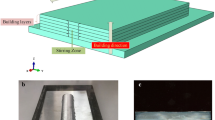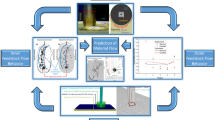The additive friction stir process provides a new approach to additive manufacturing by depositing and coating of a variety of similar and dissimilar materials with imparting them exceptional mechanical properties. During this process, the filler material can be deposited layer-by-layer on the substrate effected by heat and plastic deformation due to friction between the filler rod and substrate. For understanding complex physics of this advanced process, a numerical simulation model for the first layer deposition with the smoothed particle hydrodynamics method was constructed and implemented in an LS-DYNA commercial complex. The temperature distribution, material deposition, deformation and stress state were evaluated on the basis of simulation results. The Vickers hardness distribution was also measured in the experiment to verify the stress distribution. A higher stress observed on the top layer of deposition and Vickers hardness appeared to be similar characteristics due to the relationship between stress and hardness.







Similar content being viewed by others
References
F. Calignano, D. Manfredi, E. P. Ambrosio, et al., “Overview on additive manufacturing technologies,” Proc. IEEE, 105, No. 4, 593–612 (2017).
S. Mellor, L. Hao, and D. Zhang, “Economics additive manufacturing?: A framework for implementation,” Int. J. Prod. Econ., 149, 194–201 (2014).
M. Yakout, A. Cadamuro, M. Elbestawi, and S. Veldhuis, “The selection of process parameters in additive manufacturing for aerospace alloys,” Int. J. Adv. Manuf. Technol., 92, Nos. 5–8, 2081–2098 (2017).
J. Lee, J. An, and C. Chua, “Fundamentals and applications of 3D printing for novel materials,” Appl. Mater. Today, 7, 120–133 (2017).
R. Leal, F. Barreiros, L. Alves, et al., “Additive manufacturing tooling for the automotive industry,” Int. J. Adv. Manuf. Technol., 92, 1671–1676 (2017).
Y. Suyuan and Z. Baolei, “Experimental study of electron beam welding of magnesium alloys,” Rare Metals, 30, No. 1, 364–369 (2011).
C. Ng, M. Savalani, M. Lau, and H. Man, “Microstructure and mechanical properties of selective laser melted magnesium,” Appl. Surf. Sci., 257, No. 17, 7447–7454 (2011).
W. Xin, “Forming characteristics of thin-walled samples by metal fused-coating additive manufacturing,” Int. J. Adv. Manuf. Technol., 96, No. 27, 2367–2372 (2018).
M. Gussev, N. Sridharan, M. Norfolk, et al., “Effect of post weld heat treatment on the 6061 aluminum alloy produced by ultrasonic additive manufacturing,” Mater. Sci. Eng. A, 684, 606–616 (2017).
S. Palanivel, P. Nelaturu, B. Glass, and R. Mishra, “Friction stir additive manufacturing for high structural performance through microstructural control in an Mg based WE43 alloy,” Mater. Design, 65, 934–952 (2015).
M. Yuqing, K. Liming, H. Chunping, et al, “Formation characteristic, microstructure, and mechanical performances of aluminum-based components by friction stir additive manufacturing Tool rotation,” Int. J. Adv. Manuf. Technol., 83, Nos. 9–12, 1637–1647 (2016).
J. K. Schultz, System for Continuous Feeding of Filler Material for Friction Stir Welding, Processing and Fabrication, US Patent US20120279441A1 (2012).
O. Rivera, P. Allison, J. Jordon, et al., “A Microstructures and mechanical behavior of Inconel 625 fabricated by solid-state additive manufacturing,” Mater. Sci. Eng. A, 694, 1–9 (2017).
K. Kandasamy, L. E. Renaghan, J. R. Calvert, et al., “Solid-state additive manufacturing of aluminum and magnesium alloys,” in: Proc. of the Materials Science and Technology Conference and Exhibition 2013 (MS&T’13, Oct. 27–31, 2013, Montreal, Quebec, Canada), Curran Associates, Inc. (2013), pp. 59–69.
K. H. Muci-Küchler, E. Saint, J. Street, et al., “Simulation of a refill friction stir spot welding process using a fully coupled thermo-mechanical FEM model,” J. Manuf. Sci. Eng., 132, No. 1, 014503 (2010).
J. J. Monaghan, “Smoothed particle hydrodynamics,” Annu. Rev. Astron. Astrophys., 30, 543–574 (1992).
W. Pan, D. Li, A. M. Tartakovsky, et al., “A new smoothed particle hydrodynamics non-Newtonian model for friction stir welding: Process modeling and simulation of microstructure evolution in a magnesium alloy,” Int. J. Plasticity, 48, 189–204 (2013).
P. W. Cleary, J. Ha, M. Prakash, T. Nguyen, “3D SPH flow predictions and validation for high pressure die casting of automotive components,” Appl. Math. Model., 30, No. 11, 1406–1427 (2006).
Y. Xi, M. Bermingham, G. Wang, and M. Dargusch, “SPH/FE modeling of cutting force and chip formation during thermally assisted machining of Ti6Al4V alloy,” Comp. Mater. Sci., 84, 188–197 (2014).
D. Lv and Y. Zhang, “Numerical simulation of chipping formation process with smooth particle hydrodynamic (SPH) method for diamond drilling AIN ceramics,” Int. J. Adv. Manuf. Technol., 96, Nos. 5–8, 2257–2258 (2018).
Z. B. Wang, R. Chen, H. Wang, et al., “An overview of smoothed particle hydrodynamics for simulating multiphase flow,” Appl. Math. Model., 40, Nos. 23–24, 9625–9655 (2016).
J. Xu, “Heat transfer with explicit SPH method in LS-DYNA,” in: Proc. of the 12th Int. LS-DYNA Users Conference (June 3–5, 2012, Detroit, USA) (2012), pp. 1–12.
J. R. Cahoon, W. H. Broughton, and A. R. Kutzak, “The determination of yield strength from hardness measurements,” Metall. Trans., 2, No. 7, 1979–1983 (1971).
Acknowledgments
The research was sponsored by the Plateau Disciplines in Shanghai (No. A1-5701-18-007-03) and Academic Discipline Project of Shanghai Dianji University (No. 16TSXK01).
Author information
Authors and Affiliations
Corresponding author
Additional information
Translated from Problemy Prochnosti, No. 1, pp. 31 – 39, January – February, 2020.
Rights and permissions
About this article
Cite this article
Yang, H.G. Numerical Simulation of the Temperature and Stress State on the Additive Friction Stir with the Smoothed Particle Hydrodynamics Method. Strength Mater 52, 24–31 (2020). https://doi.org/10.1007/s11223-020-00146-1
Received:
Published:
Issue Date:
DOI: https://doi.org/10.1007/s11223-020-00146-1




